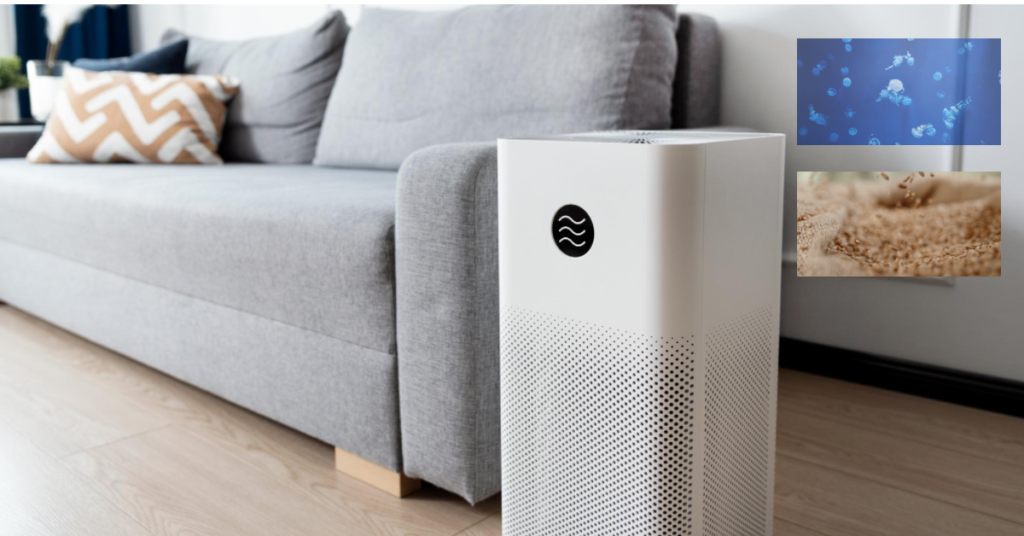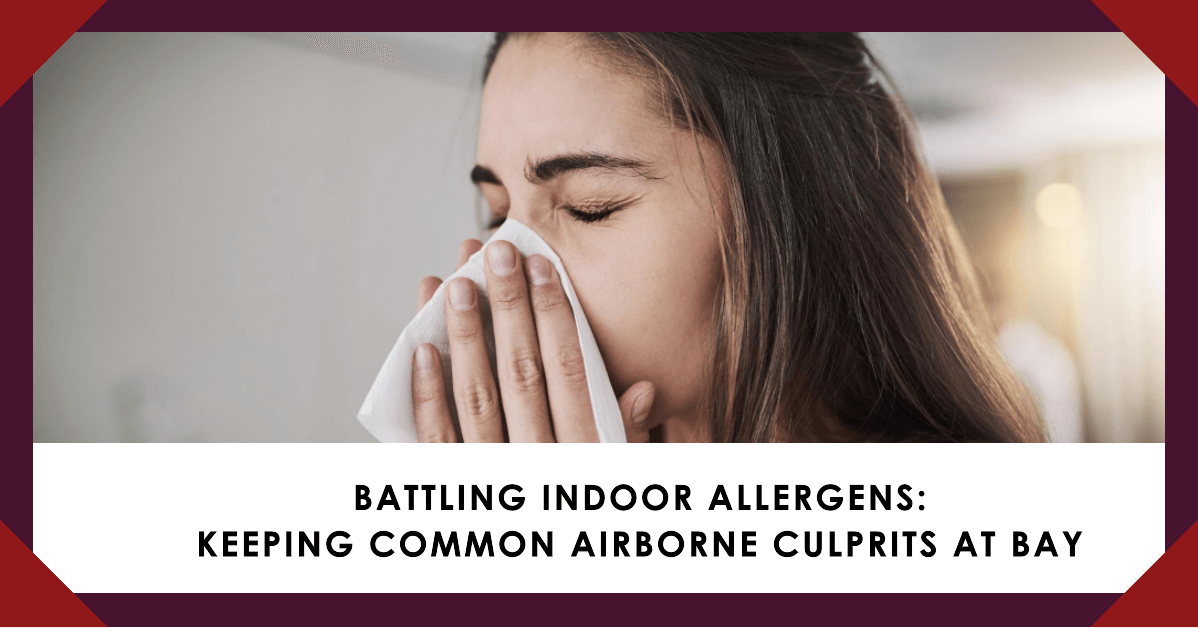Indoor allergens are a common problem actually they are tiny troublemakers. They can cause sneezing, itching, and other allergic reactions. Indoor air quality plays a very crucial role in our overall health. Indoor spaces can have many allergens that affect our well-being. We will explore indoor allergens, find out which ones are common, and give you useful ways to fight them off and keep your indoor air clean.
What Are Indoor Allergens?
Indoor allergens are microscopic particles or substances that can cause allergies in people. These are often found inside our homes and buildings. The most Common Indoor Allergens include dust mites, pet dander, mold and pollen.
Common Indoor Allergens
Dust Mites are among the most notorious indoor allergens. People with an Allergy to House Dust Mites often experience symptoms like sneezing and itching. Pet Dander, especially from cats, is another significant source of indoor allergies. Additionally, Pollen Allergens can enter your home unnoticed and wreak havoc on your health. Mold Spores thrive in damp environments, posing a risk to indoor air quality. Lastly, we can’t forget about Cockroach Droppings, which are hidden threats that can worsen allergies.
| Indoor Allergen | Allergen Explanation |
|---|---|
| Mold | Mold is a fungus type that can grow in damp areas and its spores can trigger allergies when inhaled. |
| Cockroaches | We see cockroaches in kichen or furniture. These cockroaches are common household pests whose droppings and saliva can cause allergic reactions. |
| Dander | Dander consists of tiny flakes of skin shed by pets like cats and dogs, and it can trigger allergies in some people. |
| Pollen | Pollen are produced from plants these are a fine, powdery substances, and it can enter your home and cause allergies, especially during certain seasons. |
| Dust Mites | Dust mites are microscopic insects that thrive in household dust and can provoke allergic symptoms. |
| Dust | Household dust is a mixture of various particles, including dust mites, pollen, and skin flakes, that can trigger allergies. |
| Rodents | Rodents like mice and rats can leave behind urine, droppings, and hair that contain allergenic proteins. |
| Mouse | Mice are small rodents that can contribute to indoor allergens through their urine, droppings, and dander. |
| Insects | Insects like cockroaches and beetles can be sources of indoor allergens, particularly their droppings and body parts. |
| Fungi | Fungi are microorganisms like molds and mildews that release spores, which can be allergenic when inhaled. |
| Mite | Mites are tiny arachnids related to spiders and can be found in dust and bedding, potentially causing allergies. |
| House Dust Mite | House dust mites are a specific type of mite that lives in household dust and can trigger allergic reactions. |

Symptoms of Indoor Allergies
Indoor allergies can cause various symptoms. These symptoms can range from mild to severe. Common symptoms include:
Sneezing: Frequent sneezing, especially in the morning.
Runny or Stuffy Nose: Nasal congestion or a runny nose.
Itchy Eyes: Red, itchy, or watery eyes.
Coughing: Persistent cough.
Wheezing: A whistling sound while breathing.
Skin Rashes: Itchy or red skin patches.
How to indentify Indoor Allergens
Identifying the specific allergen causing your symptoms is important. It can be done through allergy testing or by observing when and where symptoms occur in your body.
Allergy Testing
- Skin Prick Test: Small amounts of allergens are placed on your skin to see if a reaction occurs or not.
- Blood Test: Measures the level of allergy causing antibodies in your blood. Go and do it in lab.
Observation
- Track Symptoms: Note when and where symptoms occur.
- Identify Patterns: Look for patterns in your environment and activities.

Reducing Indoor Allergens
Reducing indoor allergens can help alleviate symptoms. Here are some effective strategies:
Dust Mite Control
- Use Allergen-Proof Bedding: Encase mattresses and pillows in allergen-proof covers.
- Wash Bedding Regularly: Wash sheets, pillowcases, and blankets weekly in hot water.
- Vacuum Frequently: Use a vacuum with a HEPA filter to reduce dust.
Pet Dander Control
- Limit Pet Access: Keep pets out of bedrooms and other sleeping areas.
- Bathe Pets Regularly: Bathing can reduce dander.
- Use HEPA Air Purifiers: These can help remove pet dander from the air.
Mold Control
- Fix Leaks: Repair any leaks in your home to prevent mold growth.
- Use Dehumidifiers: Keep indoor humidity below 50%.
- Clean Damp Areas: Regularly clean bathrooms, kitchens, and basements.
Pollen Control
- Keep Windows Closed: During high pollen seasons, keep windows and doors closed.
- Use Air Conditioning: This can help filter out pollen.
- Shower After Being Outside: This removes pollen from your skin and hair.
General Allergen Control
- Clean Regularly: Dust and vacuum your home frequently.
- Use HEPA Filters: Install HEPA filters in your HVAC system.
- Declutter: Reduce clutter to minimize dust accumulation.
Cleaning Tips for Reducing Allergens
Proper cleaning can significantly reduce indoor allergens. Here are some tips:
Dusting
- Use Damp Cloths: A damp cloth traps dust better than a dry one.
- Dust High to Low: Start with higher surfaces and work your way down.
Vacuuming
- Vacuum Carpets and Rugs: At least twice a week.
- Use a HEPA Vacuum: This helps trap allergens more effectively.
Washing
- Wash Curtains and Blinds: Every few months.
- Clean Hard Surfaces: Use a damp mop on floors and surfaces.
Air Purification
- Use HEPA Air Purifiers: Place them in bedrooms and living areas.
- Change Filters Regularly: Follow the manufacturer’s instructions.
Long-Term Allergen Management
Managing indoor allergens is an ongoing process. Consistency is key to reducing allergen levels in your home.
Regular Maintenance
- Schedule Cleaning: Set a regular cleaning schedule to keep allergens at bay.
- Monitor Humidity: Use a hygrometer to keep track of indoor humidity levels.
- Replace Filters: Regularly change filters in air purifiers and HVAC systems.
Lifestyle Adjustments
- Choose Allergy-Friendly Plants: Some indoor plants can help purify the air.
- Avoid Smoking Indoors: Smoke can exacerbate allergy symptoms.
- Limit Carpets: Consider hardwood or tile floors instead of carpets.
Indoor allergens can significantly impact your health and comfort. By identifying and managing these allergens, you can improve your indoor environment and reduce allergy symptoms. Regular cleaning, proper maintenance, and lifestyle adjustments are key to keeping your home allergen-free.
Note: “Airpurifiermaster does not offer medical guidance, diagnoses, or treatments. Any content presented on this website or associated with this brand is not meant to replace medical advice. It is essential to consult a healthcare professional before making any decisions or taking action based on the information provided.”
Frequently Asked Questions (FAQ’s) :
What are indoor allergens?
Indoor allergens are microscopic particles that can trigger allergic reactions in individuals sensitive to them. Common sources include dust mites, pet dander, pollen, mold spores and cockroach droppings.
How can I reduce exposure to dust mites?
You can reduce exposure to dust mites by using allergen proof mattress and pillow covers, washing bedding in hot water and maintaining a regular cleaning routine that includes vacuuming and dusting.
Can indoor plants help improve indoor air quality?
Yes, certain indoor plants are known for their air purifying properties. Plants like spider plants, snake plants and peace lilies can help remove pollutants from the air.
How do air purifiers work to reduce allergens?
Air purifiers with HEPA filters can capture and remove airborne allergens, including dust mites, pet dander and pollen, leading to improved indoor air quality.
What is the optimal indoor humidity level for preventing allergens?
Maintaining indoor humidity levels between 30% and 50% can help discourage the growth of dust mites and mold, reducing indoor allergen levels
What is the most common indoor allergy?
The most common indoor allergy is caused by dust mites, which are tiny insects that live in household dust. When people are allergic to dust mites, they often experience symptoms like sneezing, itching and a runny or stuffy nose.
What are examples of indoor allergens?
Examples of indoor allergens are substances that can trigger allergies indoors. These include dust mites, which are small insects, as well as pet dander (tiny flakes of skin shed by pets), pollen, mold spores (tiny particles released by molds) and even droppings from cockroaches.
How do you know if you have indoor allergies?
You might have indoor allergies if you notice symptoms like sneezing, a runny or congested nose, itchy or watery eyes or skin rashes when you spend time indoors, especially in certain areas of your home.
What are uncommon indoor allergens?
Uncommon indoor allergens can vary depending on an individual’s sensitivities. Some less common indoor allergens may include indoor plants, certain types of foods, specific household chemicals or even unusual items like latex or rubber.
Do air purifiers help with allergies?
Yes, air purifiers can be helpful for allergies. They work by removing allergens like dust, pollen, pet dander and mold spores from the air, which can reduce your exposure to these triggers.
Why do I get congested indoors?
Indoor congestion can occur because of the presence of allergens indoors, such as dust mites, pet dander or mold spores, which can irritate your nasal passages and lead to congestion.
What am I allergic to in my bedroom?
In your bedroom, common indoor allergens you might be allergic to include dust mites (found in bedding and carpets) or pet dander if you have pets that spend time in your room.
What triggers allergies at home?
Allergies at home can be triggered by various factors, including dust, pet hair, mold growth, pollen that enters through open windows or on clothing and certain foods if you have a food allergy.
What does dust mite allergy look like?
Dust mite allergies can manifest as symptoms like sneezing, a runny or stuffy nose, itchy or watery eyes and skin rashes. These symptoms can vary in severity.
How do I remove allergens from my house?
To remove allergens from your home, you can take steps like regularly cleaning and dusting, using allergen-proof covers on bedding, ensuring proper ventilation and using air purifiers designed to capture allergens.
How often should I run my air purifier for allergies?
For effective allergy relief, it’s generally recommended to run your air purifier continuously, especially when you’re at home. This helps maintain cleaner air quality consistently.
What is better for allergies: humidifier or air purifier?
For allergies, an air purifier is typically more beneficial than a humidifier. Air purifiers are designed to remove allergens from the air, while humidifiers add moisture but don’t address allergen removal.
DheerajSonwane is a dedicated writer with expertise in air purification technologies. He focuses on providing well-researched content to help readers improve indoor air quality in homes and businesses. As the lead writer at AirPurifierMaster.com, Dheeraj offers practical advice his insightful reviews guide individuals in choosing the best air purifiers for their needs.


18 thoughts on “Indoor Allergens: Practical Tips for managing Indoor Allergens”